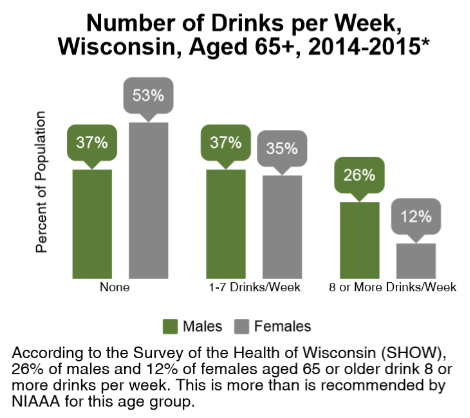Wisconsin Addiction Intervention Facts & Resources
However, rates of substance abuse in Wisconsin have been increasing in recent decades, and the state has had a long battle with alcohol abuse and alcoholism since its statehood in May of 1848.
However, rates of substance abuse in Wisconsin have been increasing in recent decades, and the state has had a long battle with alcohol abuse and alcoholism since its statehood in May of 1848.
Access to treatment for substance abuse, behavioral health issues and mental health concerns has always been difficult for Wisconsinites, but with under the weight of the opioid epidemic, the state’s infrastructure for providing care options has crumbled. The strain of the availability of drug rehab, mental health care and treatment programs in Wisconsin is most evident in Mental Health America’s (MHA) 2017 Mental Health Rankings Report, in which the state dropped from eight to 35th from 2011 to 2014.
Even worse, when it comes to access to treatment for mental health and substance abuse treatment for youth and teens, Wisconsin ranked 44th in the country. Only Virginia, Alabama, Idaho, Nevada, Oregon, Arizona and Arkansas ranked lower.
Add to this that Wisconsin ranks 48th in prevalence of mental illnesses, and the data shows that finding adequate addiction treatment and mental health care in Wisconsin is not easy.

Wisconsin has some of the highest rates of alcohol abuse, binge drinking and problematic drinking issues in the country. According to the University of Wisconsin Population Health Institute and Health First Wisconsin, excessive alcohol use costs $1,200 per person in lost productivity, premature death costs, health care costs and criminal justice costs.
Not only is heavy alcohol use widely accepted as a cultural practice, Wisconsin has some of the lowest prices for alcoholic beverages in the country, and is sold in more locations around the state.
While alcohol abuse rates in WI have slowly gotten better in recent years, drug abuse and addiction rates have exploded in the state, as they have in all other states in the U.S., thanks to the prescription drug epidemic, followed by an acute heroin epidemic, known collectively as the Great Opioid Epidemic.
The Midwest has seen some of the highest numbers of deaths due to overdoses on opioid drugs and heroin, and Wisconsin, too, has been hit with these high numbers.
Drug-related overdose deaths in Wisconsin have mirrored the increases seen on the national level, increasing every year since at least 2006:
According to the Program Participation System of the Wisconsin Department of Health Services, 6,516 individuals entered substance abuse treatment programs and drug and alcohol rehab programs in Wisconsin in 2016. Of those that entered treatment, 59.4 percent were employed, 16 percent were unemployed, and 24.6 percent were designated as “not in labor force.”
A lack of sufficient prevention and treatment options in Wisconsin has left many residents unable to find adequate addiction treatment in their state. Not only is there a lack of state-funded drug rehabs in Wisconsin, but there is also a dearth of private addiction treatment programs and treatment options.
While Gov. Scott Walker has promised to attack the opioid epidemic that has put a strain on the availability of addiction treatment, which was lacking even before the epidemic, such treatment infrastructure will take time to implement.
Along with the exploding rates of drug and alcohol addiction in WI comes the need for proper drug and alcohol addiction treatment. With so few options for addiction treatment in Wisconsin that include a truly comprehensive program, and even fewer options that can offer help for mental health issues and substance abuse, Wisconsin residents can benefit from Intervention Helpline services.
At Intervention Helpline, we can help you with the process of reviewing and vetting available options for treatment in Wisconsin, and assist with treatment planning and case management. For chronic and complex addiction cases – such as prescription drug addiction, heroin addiction, alcoholism, and dual diagnosis needs – we recommend having a guide to assist your family throughout the treatment process, in the form of case management.
Watch this 1-minute to know what to look for in a drug interventionist:
Call or message Intervention Helpline today, and we can answer your addiction and substance abuse treatment questions, or help you to take the first steps toward getting a loved one help for their substance problems.





 All Rights Reserved | Privacy Policy | HIPAA Privacy Policy | Sitemap
All Rights Reserved | Privacy Policy | HIPAA Privacy Policy | Sitemap